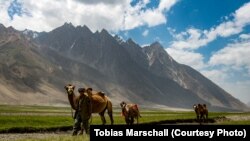WAKHAN, Afghanistan -- The picturesque northeastern province of Badakhshan in Afghanistan has long been a sightseeing destination for Afghans and foreigners alike.
Every year hundreds of tourists, particularly foreign backpackers, have flocked to a remote, peaceful region to experience the landscape of the high-peaked Pamir Mountains, rivers, and natural springs that comprises the Wakhan Corridor within Badakhshan. For many globetrotters, experiencing Wakhan, a narrow strip of territory connecting Afghanistan to northwestern China while separating Tajikistan from Pakistan's Gilgit-Baltistan region, is a bucket-list opportunity.
But the rampant spread of the coronavirus pandemic in addition to closed borders for travel has made it much more challenging for foreigners to access the remote corridors of the province.
“Hundreds of foreign tourists from various countries around the world would come and visit the different districts of Badakhshan, and many of them would often stay at my guesthouse, where I would provide them with everything they need,” Qubaduddin, a local travel host, told Radio Free Afghanistan.
Qubaduddin has been guiding and arranging travel for foreign tourists in his hometown of Wakhan for six years, but he says fewer foreigners are coming now because of the pandemic.
“Normally, I arrange transportation and accommodation for guests. I have two cars, one guesthouse, and four horses. Guests could rent my cars to drive throughout the villages. In areas where traveling by car is difficult, they would resort to using horses, and in return I would receive a large sum of money for the services I provided. On a yearly basis, I made around $10,000 from all of these services, and it helped me out a lot,” he added.
Last year, Qubaduddin hosted 35 foreign tourists. This year, he hosted zero.
“This year, like other years, I prepared myself for foreign visitors, but because of the coronavirus not one foreigner came to visit Wakhan, and specifically my guesthouse. This is worrisome for me and my eight workers, as we are all struggling financially,” he said.
Sediqi Larzad heads the tourism department in Badakhshan’s directorate of information and culture ministry. He tells Radio Free Afghanistan that a combination of three issues has weakened tourism in the province: the pandemic, closed borders, and unsafe routes between Kabul and Badakhshan, resulting in no foreign tourists in the past six months.
Despite Afghanistan as a country not being the typical global tourist hotspot due to mounting insecurity, the province of Badakhshan was always one of the exceptions to this rule. Badakhshan specifically has long had a reliable number of internal and external visitors year-round.
The fact that the more than four decades of war have hardly touched Wakhan made it a major attraction for Western adventure seekers looking for experiencing the lives of some of the most remote communities on the globe.
Last year, Badakhshan hosted 475 foreign visitors and more than 45,000 Afghan visitors, according to local officials.
“We had the biggest influx of foreign visitors and tourists last year. Unfortunately, we expected the number of tourists to increase this year, but due to the coronavirus, we could not receive even one foreign tourist,” Larzad said.
Badakhshan is trying hard to attract more Afghan tourists in order to make up for lost revenue from foreigners. But the economy has already faced a downward spiral and the current situation has rendered travel to the remote region nearly impossible.
Naqibullah Saqidyar, provincial director of the Afghan information and culture ministry, says the lack of foreign tourists has significantly affected the economy of the province, especially for those involved in the tourism and hospitality industry.
“Tourist centers are all closed, leaving a large gap in the economy for the locals. Twelve companies offered transportation and accommodation for foreigners, and two of those companies canceled their licenses [because of no business],” he said.
As part of its appeal, Badakhshan is home to one of the largest national parks in the country. A host of wildlife inhabits the area including snow leopards, Afghanistan’s national animal. And its main districts Wakhan, Shughnan, and Shuhada are renowned for their unspoiled natural beauty.
Nilly Kohzad wrote this story based on Radio Free Afghanistan correspondent Nimatullah Ahmadi’s reporting from Badakhshan, Afghanistan.










